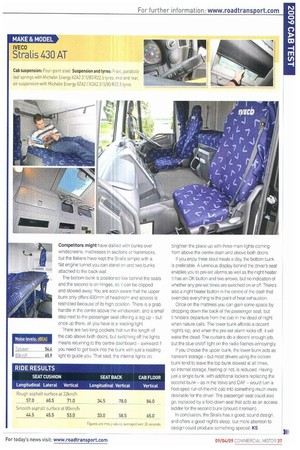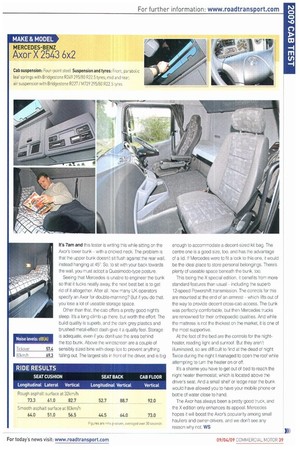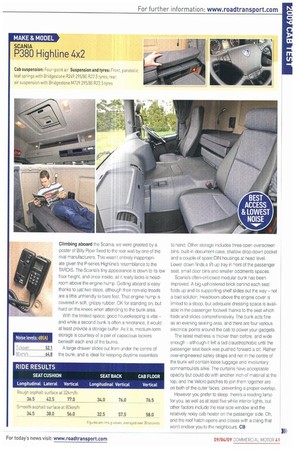DAF's CF85 Space Cab is the perfect example of the
Page 36

Page 37

Page 38

Page 39

Page 40

Page 41

Page 42

Page 43

If you've noticed an error in this article please click here to report it so we can fix it.
'tall but thin' gaffer's motor that UK fleets have been buying in order to keep their drivers happy. For anyone spending three or four nights away, this 'reward motor' has much to recommend it, not least its decent headroom (630mm more than in a regular-height CF sleeper) and excellent storage space, particularly in the headlining and under the bed.
Indeed, the CF85's cab layout based on a raised single bunk with big lockers underneath is an object lesson in what domestic long-haul drivers really need. Quite why other manufacturers fit twin bunks to a righthand-drive sleeper cab as standard is a mystery to CM.
Don't think you're losing out with the CF85's narrower cab. The CF Space Cab's 900 litres of in-cab storage space is only just behind the XF105 Space Cab's 940 litres, and much of the difference is down to the latter's larger exterior locker. In a recent cab kit test conducted by CM's sister title Truck & Driver, we ran out of cab kit before we ran out of space and that's with our full overnight gear. The decent-sized (and sealed) outside locker also takes all a driver's emergency gear, plus boots. hard hat and so on. so it won't clutter up the cab inside. Climbing into the CF is easy enough thanks to decent grab handles. The steps could be a bit deeper, but the steering wheel tilts forward a fair way. Cross-cab access is manageable too despite the CF's engine hump although having an ASTronic auto helps as there's no gear lever to climb over.
Build quality is comfortably within the 'top four' of the Premier league. After recent grumbles, the two sets of curtains are now a lot thicker. Our left-hooker CF supplied direct from Eindhoven came with a Continental-spec Webasto heater. operated via the truck's heater matrix, as opposed to the Eberspacher normally fitted to a righthooker. Being neatly flush-mounted behind the cab, the Webasto is quieter and you don't lose any space in the underbunk lockers either. It's also very powerful.
The latest 140mm-thick mattress in the CF (part of a recent interior upgrade handed down from the XF105) provided a comfortable night's sleep.
And the grumbles? Why isn't a fridge/coolbox standard? The heater controls need to be mounted on the centre of the back wall so you're left with options on which way to sleep. It also needs storage nets at either end of the bunk for books, maps or spectacles. But all in all. the CF85 Space Cab is a grand night out. BW Competitors might have dall.eo with bunks over windscreens, mattresses in sections or hammocks, but the Italians have kept the Stralis simple with a flat engine tunnel you can stand on and two bunks attached to the back wall.
The bottom bunk is positioned low behind the seats and the second is on hinges, so it can be clipped and stowed away. You are soon aware that the upper bunk only offers 630mm of headroom and access is restricted because of its high position. There is a grab handle in the centre above tne windscreen, and a small step next to the passenger seat offering a leg up but once up there, all you have is a reading light.
There are two long pockets that run the length of the cab above both doors, but switching off the lights means returning to the centre dashboard awkward if 54.4 you need to get back into the bunk with just a reading 65.9 light to guide you. That said, the internal lights do
brighten the place up with three man lights coming from above the centre dash and above both doors.
If you enjoy three stout meals a day, the bottom bunk is preferable. A luminous display behind the driver's seat enables you to pre-set alarms as well as the night heater. It has an OK button and two arrows, but no indication of whether any pre-set times are switched on or off. There's also a night heater button in the centre of the dash that overrides everything to the point of heat exhaustion.
Once on the mattress you can gain some space by dropping down the back of the passenger seat, but it hinders departure from the cab in the dead of night when nature calls. The lower bunk affords a decent night's kip, and when the pre-set alarm kicks off, it will wake the dead. The curtains do a decent enough job, but the blue on/off light on the radio flashes annoyingly.
If you choose the upper bunk, the lower bunk acts as transient storage but most drivers using the bottom bunk tend to leave the top bunk stowed at all times, so internal storage, fleeting or not, is reduced. Having just a single bunk, with additional lockers replacing the second bunk as in the Volvo and DAF would turn a fleet-spec run-of-the-mill cab into something much more desirable for the driver. The passenger seat could also go, replaced by a fold-down seat that acts as an access ladder for the second bunk (should it remain).
In conclusion, the Stralis has a good, sound design. and offers a good night's sleep, but more attention to design could produce something special. KS Spending the night in the MAN proved, on the whole, to be a comfortable experience. The bed is long and wide enough for any tall and sturdy person to sleep soundly, and once you are comfortably inside your sleeping bag. the light switches are all within easy reach, with storage areas nearby to keep a drink bottle or book. It is possible to adjust the night heater, operate the lights, open the windows, turn on the radio/CD player and set the alarm without getting out of the bunk.
The mattress rests on a slatted frame and, in case you forget your pillow, MAN provides two mini cushions.
A central stowage console provides a large drawer and space for items such as glasses, pens or a cup.
The steering column and seats are very easy to adjust which makes it a simple task to move around the cab.
There's more than enough headroom and space to dress, while the various white and red interior lights provide acceptable lighting. 55.6 A built-in alarm clock, conveniently located just above your head, is guaranteed to wake you up in the morning.
A good quality radio with controls that are easy to navigate in the dark is located on the dashboard.
There are plenty of places on the dash for cups and cans, as well as space for items such as a wallet, mobile phone, map or sunglasses case.
The night heater can be set to various temperatures, and even at full blast is so quiet you don't realise it's on. Electric windows on both the driver and passenger sides are simple to operate.
Stowage units in the cab provide ample space for luggage and other equipment The top bunk provides plenty of room for bags. clothes and bedding, and holds it all in place when it is half-extended.
One criticism is that it can prove very difficult to retrieve your mobile phone should it accidentally drop under the bunk as this tester found out to his cost.
Also, the window curtains can be a little awkward to pull around the rail, as well as a bit cumbersome to tie back in place again with the Velcro tags.
However, this task might prove easier with practice. With the bunk curtains pulled across, the sleeping area is dark, although in the morning they let in a fair amount of light.
Overall, the MAN'S interior build quality is excellent and the controls and compartments are clearly and neatly positioned. The cab is straightforward to use, easy to navigate and refreshingly devoid of gimmicks. RB It's 7am and this tester is writing this while sitting on the Axor's lower bunk -with a cricked neck. The problem is that the upper bunk doesn't sit flush against the rear wall, instead hanging at 45. So, to sit with your back towards the wall, you must adopt a Quasimodo-type posture.
Seeing that Mercedes is unabie to engineer the bunk so that it tucks neatly away, the next best bet is to get rid of it altogether. After all. how many UK operators specify an Axor for double-manning? But it you do that, you lose a lot of useable storage space.
Other than that, the cab offers a pretty good night's sleep. It's a long climb up there, but worth the effort, The build quality is superb, and the dark grey plastics and brushed metal-effect dash give it a quality feel. Storage is adequate, even if you don't use the area behind the top bunk, Above the windscreen are a couple of 57.4 sensibly sized bins with deep lips to prevent anything 69.3 falling out. The largest sits in front of the driver, and is big
enough to accommodate a decent-sized kit bag. The centre one is a good size, too, and has the advantage of a lid. If Mercedes were to fit a lock to this one, it would be the ideal place to store personal belongings. There's plenty of useable space beneath the bunk, too.
This being the X special edition, it benefits from more standard features than usual including the superb 12-speed Powershift transmission. The controls for this are mounted at the end of an armrest which lifts out of the way to provide decent cross-cab access. The bunk was perfectly comfortable, but then Mercedes trucks are renowned for their orthopaedic qualities. And while the mattress is not the thickest on the market, it is one of the most supportive.
At the foot of the bed are the controls for the nightheater, reading light and sunroof. But they aren't illuminated, so are difficult to find at the dead of night. Twice during the night I managed to open the roof while attempting to turn the heater on or off.
It's a shame you have to get out of bed to reach the night heater thermostat, which is located above the driver's seat. And a small shelf or ledge near the bunk would have allowed you to have your mobile phone or bottle of water close to hand.
The Axor has always been a pretty good truck, and the X edition only enhances its appeal. Mercedes hopes it will boost the Axor's popularity among small hauliers and cwneedrivers, and we don't see any reason why not. WS When climbing aboard the Renault in the dark, opening the door operates the welcoming interior lighting for approximately 20 seconds plenty of time to enter the roomy cab and set the lighting as you wish by depressing the light covers themselves above the centre of the dashboard.
Once in, there is ample room to move around, and thanks to the flat floor, it is easy to stand. This allows comfortable access to the generous overhead storage. There are two good-sized lockers on the driver's side, while on the nearside there is a large shelf that is suitable for a microwave or TV an added bonus.
More storage is available beneath the lower bunk, including two large drawers and a sizeable fridge for cold drinks and food. There is also a wardrobe/storage area at one end of the bunk which is big enough to 56.0 swallow a pillow so it is best to sleep with your head 68.1 on the nearside of the cab.
The Premium came with a generous, comfortable mattress and a floor panel by the driver's seat containing all the controls necessary for a hassle-free night. Here you can open and close the roof hatch, lock the cab doors and adjust the all-important night heater without leaving the bed.
The heater itself is very effective and more than adequate at its minimum setting. It is adjusted by the simple turning of a numbered wheel in the panel. There are two buttons for the heater, one of which has a light permanently on so you can find the controls in the dark.
By pressing the button next to this you turn the heater on, but unless you can hear the heater start there is nothing to tell you it is operational a minor point that had this tester thinking at 5.30am when the cab required a little warming.
The only other criticism concerns the top bunk; this is designed to fold down in the middle, which cramps the available space for sleeping in the lower bed. However with a bit of effort it is possible to get it to fold up and instantly create a much more comfortable environment. This design of bunk is not exclusive to Renault, which makes it all the more surprising no one has made it fold upwards; it would be easy to achieve and increase driver comfort tenfold at a stroke.
Overall, the Renault cab performed really well, and apart from those two little gripes, was better than some hotels, TL
Climbing aboard the Scania, we were greeted by a poster of Billy Piper fixed to the rear wall by one of the rival manufacturers. This wasn't entirely inappropriate given the P-series Highline's resemblance to the TARDIS. The Scania's tiny appearance is down to its low floor height, and once inside, all it really lacks is headroom above the engine hump. Getting aboard is easy thanks to just two steps, although their non-slip treads are a little unfriendly to bare feet. That engine hump is covered in soft, grippy rubber, OK for standing on. but hard on the knees when attending to the bunk area.
With the limited space, good housekeeping is vital and while a second bunk is often a hindrance, it would at least provide a storage buffer. As it is, medium-term storage is courtesy of a pair of capacious lockers beneath each end of the bunks.
A large drawer slides out from under the centre of the bunk, and is ideal for keeping daytime essentials to hand. Other storage includes three open overscreen bins, built-in document case, shallow drop-down pocket and a couple of spare DIN housings at head level. Lower down finds a lift-up tray in front of the passenger seat, small door bins and smaller oddments spaces.
Scania's often-criticised modular bunk has been improved. A big upholstered brick behind each seat folds up and its supporting shelf slides out the way not a bad solution. Headroom above the engine cover is limited to a stoop, but adequate dressing space is available in the passenger footwell thanks to the seat which folds and slides comprehensively. The bunk acts fine as an evening seating area, and there are four various electrical points around the cab to power your gadgets.
The latest mattress is thicker than before. and wide enough although it felt a tad claustrophobic until the passenger seat back was pushed forward a bit. Rather over-engineered safety straps and net in the centre of the bunk will contain loose luggage and involuntary somnambulists alike. The curtains have acceptable opacity but could do with another inch of material at the top, and the Velcro patches to join them together are on both of the outer faces, preventing a proper overlap.
However you prefer to sleep, there's a reading lamp for you, as well as at least five white interior lights, but other factors include the rear side window and the relatively noisy cab heater on the passenger side. Oh, and the roof hatch opens and closes with a clang that won't endear you to the neighbours. CB "You guys sleeping in trucks tonight?" the sportscar test engineer asked us as we walked to the control tower. "You're not going to get much sleep with us testing here."
But Volvo's FM with Globetrotter LXL cab provided a restful slumber, well insulated as it was from the thrum of high-revving V12 test cars running laps 80 yards away.
Climbing aboard the FM, you get a sense of luxury. Three overhead lockers dominate the cab good for drivers on long trips because there's enough storage for kit bags and the like.
While the front lockers were welcomed on the overnight test. they did intrude in the cab making clothes changes slightly awkward. But that may be more as a result of the truck's steeply raked windscreen.
As the FM is Volvo's fleet offering, it doesn't have a completely flat floor like the FH, but despite the 55.3 pronounced engine hump. the Swedish manufacturer 65.4 has cut a step on the passenger side to accommodate
taller drivers. This six-foot tester had headroom to spare.
The night heater switch is conveniently located on the wall midway between the driver's and passenger's seats, along with reading and cab light switches. and a simple turn of the black dial increases or decreases output.
The Globetrotter LXL cab can be configured in various ways and ours came with more storage bins in place of a top bunk. The one cubicle houses a small bar fridge to keep food and drinks cool, and will definitely score highly with drivers.
The Volvo's mattress is thick and comfy and sits on a solid wooden base that provides extra support and rigidity. There's no issues with size either as it is the third widest in the test. While it's also the second shortest, a 2.000mm bed is hardly inadequate.
After a long day's driving, be mindful where you rest your head, because a solid steel safe is positioned at the end of the lower bunk behind the passenger seat. We decided not to risk concussion and were forced to prop pillows to the left, behind the driver's chair.
The lack of cloud meant the sun was beaming by 6.30am. With the sky-blue and grey-coloured curtains drawn, a large amount of sunlight still penetrated the cab and there was no chance of a lie-in past 7am.
The Swede might not boast the biggest cab in our test, but it is one of the most functional. Storage space is top of the agenda and buttons and dials are always within arm's length. The Globetrotter LXL is a luxurious cab with all the creature comforts a driver could want. IT Let's get the cliché out of the way no one makes a bad cab any more. Each contender has its strengths, but none fails to provide adequate overnight accommodation to a weary driver. So the differences are down to the details. It could be argued that if you're aware of any details, they've failed, since awareness tends to turn into annoyance, such as with the lveco radio's flashing blue light and the Merc's half-stowing upper bunk.
Among the high points, the small but perfectly formed Scania provided the best access thanks to well-located steps leading to a low floor and a steering wheel that gets fully out of the way. No one had harsh words over mattress comfort, but the Merc's gives excellent support. The Renault Premium is the best choice for drivers in need of storage. Not for the first time, Scania's contender takes some beating for noise suppression. And the single-bunk OAF gets the vote for the most usable space.
Night heater testing
Mayoe it really is global warming, or maybe it was just a mild evening. Either way, the cab heaters didn't get challenged by an ambient temperature that hovered around 12°C during the evening test and never fell below 9°C throughout the night. Even the lowest performing lveco managed to clear 30°C and it seems that a more than adequate night heater is becoming a given from all makers. If there is an issue now, it's over the multitude of different control systems no problem if you drive the same truck every day but if you're an agency driver (or a journalist), each system requires learning.
Ride: The results aren't clear cut this year, but in general, the DAF, Volvo, Scania and MAN gave better ride results than the other cabs. The OAF and Volvo had low levels of vertical acceleration, indicating that the cab and seat provided good isolation. However, the longitudinal accelerations in the OAF and Volvo weren't as low as in the Scania or MAN, indicating that these cabs had higher cab nod and less longitudinal isolation. Subjectively, these four cabs isolated the highfrequency inputs well, but all transmitted large discrete events as a feeling of 'abruptness'. The OAF felt `wallowy' at low frequencies, giving slightly less roll/pitch control. The Volvo cab was steel-sprung so its result is quite an achievement in relation to the ether air-sprung cabs.
The Renault and lveco had mediocre ride figures while the Mercedes had the worst. This matched subjective comments where the Renault and lveco transmitted shake, had some highfrequency inputs and suffered from "cab nod". The lveco also felt under-damped and also had poor roll/pitch control whilst the Mercedes cab felt over-sprung and under-damped.
Noise: The Scania gave the lowest noise levels at ambient and at 80km/h even though some wind noise was heard while driving. It was followed by the Iveco, Volvo and MAN which gave similar noise values. The lveco gave higher noise levels at 80km/h due to rattles that could be heard in the cab. The OAF and Renault attenuated the noise whilst idling but transmitted wind and engine noise at 80km/h.
The M-B noise levels were higher than the other cabs, partly due to the excessive "turbo whine".
















































































































































